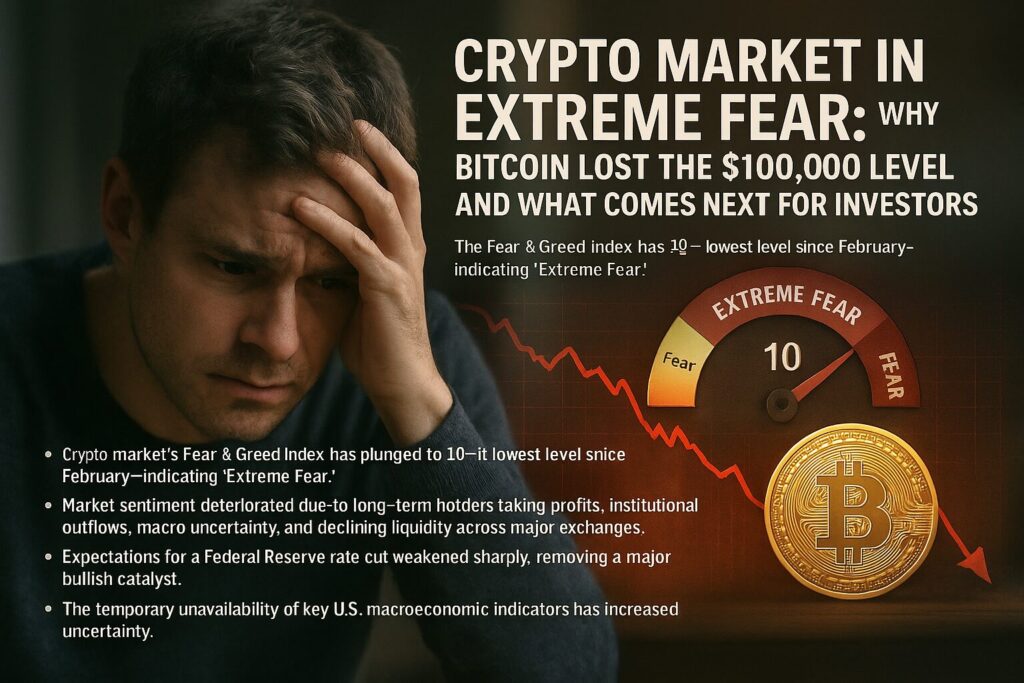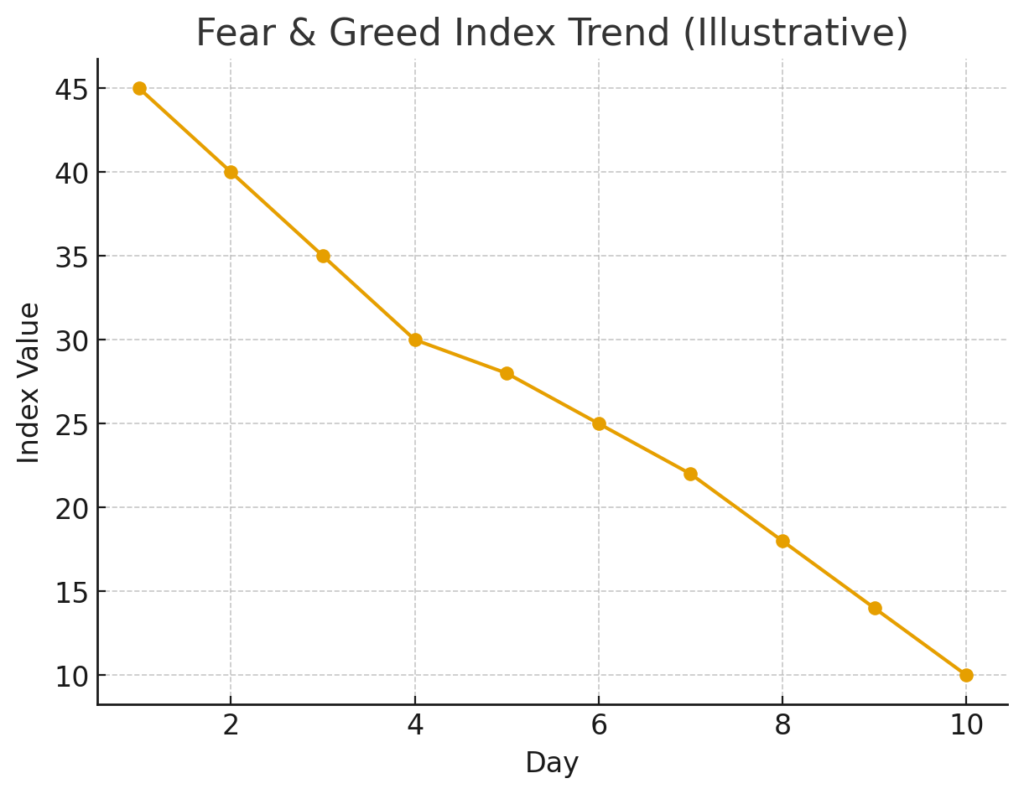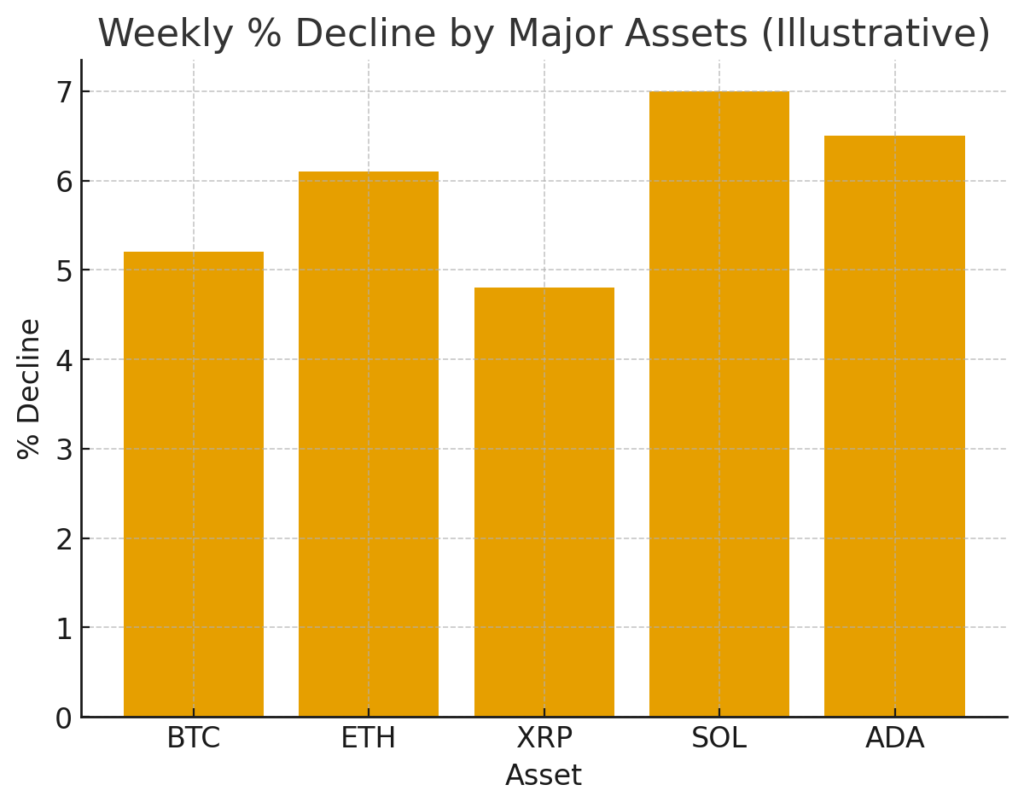
Main Points :
- The crypto market’s Fear & Greed Index has plunged to 10—its lowest level since February—indicating “Extreme Fear.”
- Bitcoin dropped more than 5% in a week, failing twice to hold the key $100,000 psychological level.
- Market sentiment deteriorated due to long-term holders taking profits, institutional outflows, macro uncertainty, and declining liquidity across major exchanges.
- Expectations for a Federal Reserve rate cut weakened sharply, removing a major bullish catalyst.
- The temporary unavailability of key U.S. macroeconomic indicators has increased uncertainty.
- The recent decline may also open opportunities for long-term investors seeking undervalued assets with strong fundamentals.

1. The Return of Extreme Fear in the Crypto Market
In mid-November 2025, the cryptocurrency market entered a renewed phase of tension as investor sentiment deteriorated rapidly. The widely referenced Fear & Greed Index, which aggregates volatility, market momentum, social sentiment, surveys, and dominance metrics, plunged to 10, signaling “Extreme Fear.” This level has not been seen since late February, almost nine months ago.
This severe decline in sentiment coincided with a week of sustained downward pressure on major cryptocurrencies. Bitcoin (BTC), which had once surged above $120,000, fell below $96,000, failing to maintain its footing in the six-figure range for the second time this month. The psychological importance of the $100,000 mark means breaching it tends to amplify fear-driven selling behavior.
The broader market followed. The CoinDesk 20 Index (CD20), representing the most traded cryptocurrencies, dropped roughly 5.8% during the same period. Such synchronized selling reflects systemic conditions rather than asset-specific weakness.
2. Why Bitcoin Led the Sell-Off

Bitcoin acted as the primary driver of the downturn due to several overlapping forces:
Long-Term Holders Taking Profits
After an extended upward rally earlier in 2025, many long-term holders (LTHs) finally began to take profits. Historically, LTH profit-taking has a strong correlation with local market tops.
Institutional Outflows
Data from Nansen and other analytics platforms indicated consistent outflows from institutional funds. This shift reduced the stabilizing presence of large, long-term capital.
Unwinding of Leveraged Long Positions
High funding rates in derivatives markets had accumulated for months. As spot prices retreated, leveraged long positions were forcefully liquidated, accelerating downward momentum.
Macro Uncertainty and Fed Rate Expectations
Much of Bitcoin’s 2024–2025 rally was supported by the narrative that the U.S. Federal Reserve would begin easing monetary policy. But the CME FedWatch Tool showed that only about 50% of traders expected a 25-basis-point rate cut in the next decision. This is a major deterioration from earlier in the year when expectations were above 80%.
Reduced Access to Economic Data
Because the U.S. government temporarily shut down earlier this quarter, the White House warned that key economic indicators, including October inflation, might not be released at all.
For global risk markets—including crypto—this means traders have less clarity, and markets tend to “price in fear” when uncertainty rises.
3. Liquidity Is Still Damaged from the October Crash
One of the overlooked drivers of the recent decline is the structural weakness in crypto liquidity. Although the massive October 2025 crash happened weeks ago, order-book depth at major centralized exchanges remains unusually thin.
This has two consequences:
- Small sell orders push prices disproportionately lower.
- Market makers remain cautious, providing less liquidity until volatility stabilizes.
Liquidity fragmentation also continues to worsen as trading volumes shift between centralized exchanges (CEXs), decentralized exchanges (DEXs), and OTC desks in unpredictable patterns.
4. Comparison with Previous Drawdowns

Historically, extreme fear phases often precede notable market turning points. Examples include:
- March 2020 (COVID crash) → Extreme fear index near 10, followed by an explosive multi-year bull run.
- July 2021 (post-China mining ban) → Fear index collapsed, then Bitcoin rallied to new highs.
- June 2022 (Celsius/Three Arrows collapse) → Severe fear, then gradual recovery into 2023.
This does NOT guarantee that a rebound will occur immediately, but historically, extreme pessimism tends to correspond to deeply discounted prices—especially for assets with strong long-term fundamentals.
5. What This Means for Investors Looking for New Crypto Opportunities
For your audience—investors seeking emerging opportunities, new crypto assets, and blockchain business models—this downturn presents both risks and strategic openings.
A. Undervalued Tokens with Utility
Tokens with real-world payment use cases, staking demand, or ecosystem incentives may become temporarily undervalued during fear-driven corrections.
B. Infrastructure and Real-World Asset (RWA) Protocols
Even during the downturn, investment flows into blockchain infrastructure (rollups, L2s, MEV solutions, real-world asset platforms) have remained relatively resilient.
C. Stablecoin and On-Chain Treasury Opportunities
When volatility rises, demand for USD-pegged assets increases. Yield-bearing USDC or USDT protocols and tokenized treasury products become more attractive.
D. Bitcoin Layer-2 Ecosystem
BTC’s high fees and recent congestion have strengthened interest in Bitcoin L2s (e.g., Stacks, Botanix, Fractal Bitcoin). Long-term infrastructure theses remain intact even if prices temporarily decline.
6. The Global Context: Macro and Regulatory Considerations
A. Federal Reserve Path Uncertain
If inflation cools but the Fed delays rate cuts, risky assets—including crypto—may face extended consolidation.
B. Missing Economic Data Means Higher Volatility
Without official CPI reports, market participants have turned to alternative data sources, including private inflation trackers and prediction markets such as Kalshi and Polymarket.
C. Liquidity Across Global Markets Is Tightening
U.S., EU, and Asian equity markets have all shown signs of reduced risk appetite. This cross-market correlation reinforces volatility in digital assets.
7. Scenario Forecast: What Happens Next?
Base Case (Likely)
Bitcoin remains between $90,000–$105,000, with volatility elevated but without a full breakdown. Traders wait for updated macro data or Fed clarity.
Bullish Case
If liquidity improves and expectations for rate cuts return, Bitcoin may reclaim $110,000–$120,000, pulling the rest of the market upward.
Bearish Case
If order-book liquidity deteriorates further, a wick down to $80,000–$85,000 is possible—especially if derivative markets unwind more aggressively.
8. Final Summary
The cryptocurrency market has entered a deep fear cycle driven by macro uncertainty, institutional outflows, reduced liquidity, and profit-taking from long-term holders. Although this has accelerated short-term declines—especially for Bitcoin—the long-term structural growth of blockchain adoption, L2 ecosystems, and real-world asset tokenization remains strong.
For investors seeking new opportunities, fear-driven markets historically offer some of the best entry points—provided they maintain strict risk management and focus on assets with real adoption potential.

